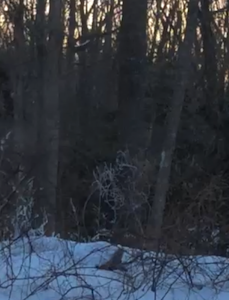
Friday, February 20, 2015 was a bitterly cold night in New England. At the University of Connecticut where the SWI is based, the overnight low was -15 F. The following morning, stone wall enthusiast Kate Johnson sent me a video-clip taken by her parents, Claire and Steve Johnson, from Little Compton, RI. It showed steam rising from a stone pile like smoke from a dying campfire. Thinking other stone wall enthusiasts might be interested, I decided to post it on the SWI website. Click on this link to see it.
IMG_0706
To understand this, let’s start with the simpler case of steam rising from a patch of open water on a frozen pond or a stream. Under calm, but not cold atmospheric conditions, the extra moisture above the liquid water is invisible because it’s water vapor, a clear gas. But when the ambient temperature becomes very cold, the air above the patch is much less dense and moist than elsewhere. So it rises, cools, and condenses into a fine mist. These tiny droplets then migrate away, evaporate in the cold dry air, and become invisible once again. Something similar happens above chimneys, drier vents, and volcanoes.
Now imagine a deep fluffy snow on a forested New England soil. The insulation of the snow adds to the insulation of the forest mulch, to prevent or restrict the depth of frozen ground. In this situation, the air within the unfrozen soil –driven by gradients of temperature and vapor pressure–migrates upward to the base of the snowback, condenses, and is frozen before it can be seen.
When the snowpack is crusted with ice, however, this upward escape of soil air is blocked. And when frozen ground is deepening, or when the water table is rising, the soil air is squeezed sideways toward a place of escape. Old stone piles and tumbled stone walls provide these avenues, becoming vents for warm moist air. The extra cold of the stones (caused by more rapid conduction of heat) may help speed up this process.
As with a patch of open water on a frozen pond, the patch of warmer-moister air beneath a stone pile rises, cools, condenses, and evaporates, producing a ghostly transient mist. The careful observer of nature gets chance to see native fieldstone steaming away.
Thanks Claire and Steve for catching this process in the act. Spread the word. Share the stone joy.
